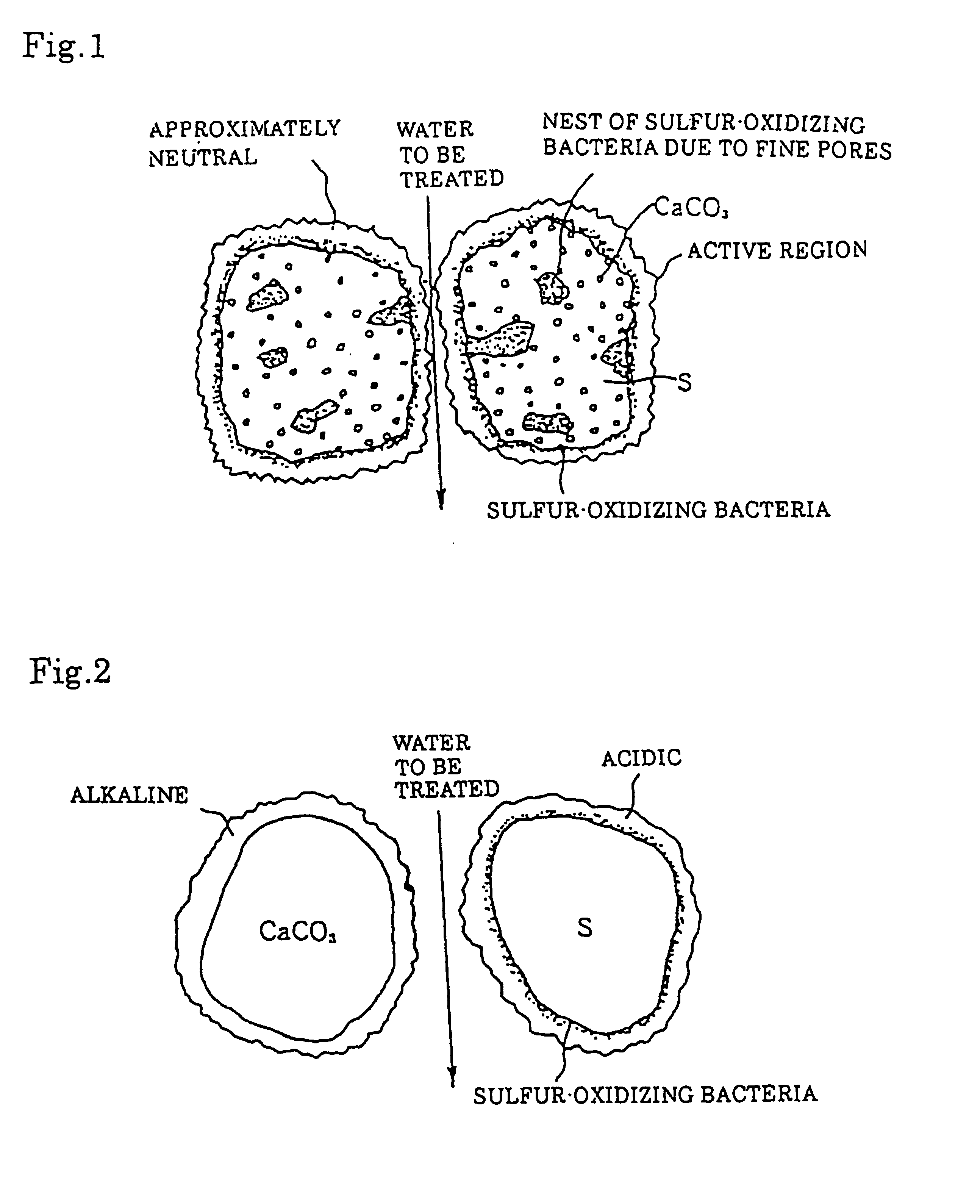Composition containing calcium carbonate particles dispersed in sulfur for removing nitrate nitrogen
a technology of calcium carbonate and sulfur, applied in the field of denitrifying composition, can solve the problems of low denitrifying efficiency per substrate, inability to complete denitrifying operation according to this process, and many treatment steps and tanks and facilities, and achieve the effect of promoting water purification
- Summary
- Abstract
- Description
- Claims
- Application Information
AI Technical Summary
Benefits of technology
Problems solved by technology
Method used
Image
Examples
example 1
[0052]In a vat were placed 10 parts by weight of calcium carbonate powder (specific surface area, 3,100 cm2 / g) and 10 parts by weight of sulfur, the contents were heated at approximately 120° C. to melt the sulfur, and mixed homogeneously by stirring. The mixture was then thrown into a large volume of water at normal temperature for rapid cooling, solidified, and crushed to prepare a denitrifying composition (invention 4) with a particle diameter of 5-10 mm.
example 3
[0057]Each of inventions 1 to 4 and comparison 1 prepared in Examples 1 and 2 and Comparative Example 1 was taken as specimen, placed in a flask together with test water, and batch-tested for denitrification at an average water temperature of 20° C. The test water was prepared by adding 1 wt % of river sediment (containing sulfur-oxidizing bacteria) sampled from underdrains in Fukaya City, Saitama Prefecture, to raw water which was an aqueous solution (aqueous KNO3) with a nitrate nitrogen concentration of, 150 mg / 1. For comparison, a test was conducted similarly free of any of the specimens by using test water containing only the river sediment.
[0058]Table 1 shows a decrease in the concentration (mg / l) of nitrates nitrogen in the batch test. Any of the inventions was confirmed to remove nitrates nitrogen of high concentration satisfactorily.
[0059]
TABLE 1StartingAfterAfterAfterAfterAfterSpecimenday5 days10 days15 days20 days30 daysInvention 1175111684514 8Invention 2175111755218 10I...
example 4
[0064]Sulfur powder was melted at 120° C., mixed homogenously with lime powder at a ratio by weight of 1:1, and the mixture was cooled rapidly and crushed to a particle diameter of 5-20 mm to prepare a denitrifying composition (invention 5). A test plant was filled with 80 kg (0.94 m3) of the composition, and effluent of the following properties from underdrains in a farm was treated by passage through the test plant: pH, 6.8-8.0; SS, 0-3 mg / l; NH4—N, 0.01 mg / l or less; NO3—N, 60-93 mg / l ; SO42−—S, 22-37 mg / l ; Ca2+, 90-132 mg / l . Before the start of the experiment, 100 g of the actual soil cultivated on the Taylor culture C, medium as microorganism source was domesticated for 8 days in a container filled with effluent from underdrains.
[0065]When the experiment was carried out by controlling the loading rate (amount of raw water per day / amount filled of denitrifying composition) at 0.5-10, removal of 99% or more of the concentration of nitrates nitrogen in raw water was obtained at ...
PUM
| Property | Measurement | Unit |
|---|---|---|
| pH | aaaaa | aaaaa |
| specific surface area | aaaaa | aaaaa |
| specific surface area | aaaaa | aaaaa |
Abstract
Description
Claims
Application Information
 Login to View More
Login to View More - R&D
- Intellectual Property
- Life Sciences
- Materials
- Tech Scout
- Unparalleled Data Quality
- Higher Quality Content
- 60% Fewer Hallucinations
Browse by: Latest US Patents, China's latest patents, Technical Efficacy Thesaurus, Application Domain, Technology Topic, Popular Technical Reports.
© 2025 PatSnap. All rights reserved.Legal|Privacy policy|Modern Slavery Act Transparency Statement|Sitemap|About US| Contact US: help@patsnap.com

